 Museo capitolare di Atri | |
| Location | Atri |
|---|---|
| Type | Religious art |
| Website | http://www.museocapitolareatri.it/ |
Museo capitolare di Atri (Italian for Chapter Museum of Atri) is a museum of religious art in Atri, Province of Teramo (Abruzzo). [1]
 Museo capitolare di Atri | |
| Location | Atri |
|---|---|
| Type | Religious art |
| Website | http://www.museocapitolareatri.it/ |
Museo capitolare di Atri (Italian for Chapter Museum of Atri) is a museum of religious art in Atri, Province of Teramo (Abruzzo). [1]
The Capitular Museum of Atri is one of the oldest museums in Abruzzo, founded in 1912. It was commissioned by Monsignor Raffaele Tini and was enriched by donations (such as ceramics from the Bindi family).
The museum is located in the upper rooms of the cloister of a Benedictine monastery from the 12th century, which in the 15th century became the residence of the cathedral canons and the episcopal cemetery. It comprises ten rooms in addition to the cloister and the crypt.
The museum houses works ranging from the 13th to the 20th century originating from the city. [1]
The museum's collection includes paintings from the 13th to the 20th century, including a detached fresco from the 13th–14th century, a Madonna attributed to Silvestro dell'Aquila dating between the 15th and 16th centuries, and a Madonna with Child by his pupil Carlo dell'Aquila, a triptych with sculptures by Tolmezzini from the early 16th century, a Madonna and Saints by Antonio Solario, a Nativity and a Flagellation attributed to Pedro de Aponte, and the Saints Francis and Leonard by Ippolito Borghesi, all from the 16th century, a Saint Reparata by Teodosio Ronci and Valerio Ronci dated 1605, a Madonna with Saints dated 1615 and attributed to Francesco Allegrini and the Cavalier d'Arpino, a Holy Family and Saints by Girolamo Cenatiempo from the 17th century, and six Scenes from the Life of Christ by Serafino Tamburelli from the 17th–18th century; more recent are three genre paintings by Tommaso Illuminati from the 20th century.
The sculpture collection includes works from the 13th–16th century, such as an altar screen of Saint James, attributed to the Moranzoni carvers' workshop [2] (15th century), a terracotta Madonna with Child by Luca della Robbia from around 1470, a wooden angel by the museum's founder, Monsignor Tini, from 1931.
Of particular interest is the collection of manuscripts, including a missal, an antiphonary, and a lectionary from Abruzzo (13th century), the "Decree of Gratian" from the mid-14th century, the "Acquaviva Missal," and a collection of legal formularies from the 15th century.
One room houses the Bindi collection, with ceramics from the 16th to 20th centuries, including a Nativity and an Adoration by Francesco Saverio Grue from the 18th century.
The collection is completed by liturgical objects from the 16th to 18th centuries, including a series of bust-reliquaries and remains of a ambo from the 13th–14th century, sacred furnishings such as sacristy cabinets and a prie-dieu by the carver Carlo Riccione (17th century), textiles, and sacred vestments from the 17th and 18th centuries. Finally, there are liturgical objects in goldsmithing from the 12th to 20th centuries, including a rock crystal reliquary from the Venetian school of the 12th century.

The province of Chieti is a province in the Abruzzo region of Italy. Its provincial capital is the city Chieti, which has a population of 50,770 inhabitants. The province has a total population of 387,649 inhabitants as of 2017 and spans an area of 2,599.58 square kilometres (1,003.70 sq mi). The province contains 104 comuni. Its provincial president is Mario Pupillo.

Teramo is a city and comune in the Italian region of Abruzzo, the capital of the province of Teramo.
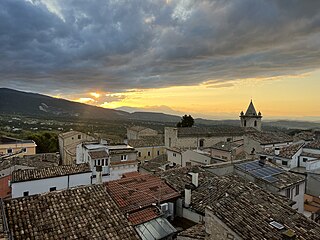
Guardiagrele is a town and comune in the province of Chieti, part of the Abruzzo region of central Italy. It is in the foothills of the Maiella mountain at an elevation of around 576 metres (1,890 ft). Its population numbers about 10,000.
Berardo is an Italian saint, patron saint of the city and diocese of Teramo.
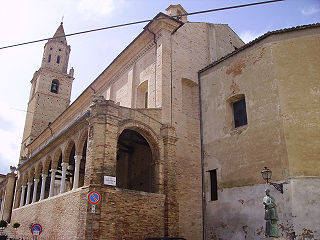
Città Sant'Angelo is a city and comune in the province of Pescara, Abruzzo, Italy. It is one of I Borghi più belli d'Italia.

Crognaleto is a comune and city of slightly less than 2,000 people in the Province of Teramo, central Italy. Crognaleto sits at an elevation of 1,105 metres (3,625 ft) and has its communal administrative offices in the frazione of Nerito. The commune of Crognaleto sits on the slopes of the Monti della Laga mountain range and extends across both the northern and the southern slopes of the Vomano Valley. It lies within the Gran Sasso e Monti della Laga National Park.
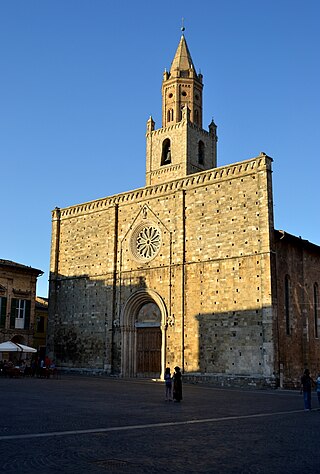
Atri is a comune in the Province of Teramo in the Abruzzo region of Italy. Atri is the setting of the poem The Bell of Atri by American writer Henry Wadsworth Longfellow. Its name is the origin of the name of the Emperor Hadrian, whose family came from the town.

Teramo Cathedral is a Roman Catholic cathedral in Teramo, Abruzzo, central Italy, dedicated to the Assumption of the Virgin Mary and to Saint Berardo, patron saint of the city. It is the seat of the Bishop of Teramo-Atri. Built in Romanesque-Gothic style, it was consecrated in 1176.
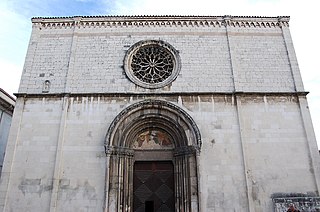
Chiesa di Santa Giusta is a Romanesque church in L'Aquila (Abruzzo).

Museo d'Arte Sacra della Marsica is a museum of religious art in Celano, Province of L'Aquila (Abruzzo).

Museo Civico di Teramo is an art museum in Teramo, Abruzzo.

Museo civico di Cerchio is a museum of religious art in Cerchio, Province of L'Aquila (Abruzzo).

Museo diocesano di Sulmona is a museum of religious art in Sulmona, Province of L'Aquila (Abruzzo).

Museo diocesano di Lanciano is a museum of religious art in Lanciano, Province of Chieti (Abruzzo).

Museo del duomo di Guardiagrele is a museum of religious art in Guardiagrele, Province of Chieti (Abruzzo).

San Nicola is a Romanesque-style, Roman Catholic church located in the town of Atri, province of Teramo, region of Abruzzo, Italy.

The Treasure Museum of the Basilica of Saint Francis contains a collection of sacred art that is on display in two halls found on the northern side of the Cloister of Pope Sixtus IV which is part of the Sacro Convento in Assisi, Italy. The entrance is found on the second level of the Renaissance cloister behind the apse of the Basilica of Saint Francis, which houses the remains of St. Francis of Assisi. Since 1986 the museum has also displayed a collection of works donated to the Conventual Franciscan Friars by the Secular Franciscan and American art critic, Frederick Mason Perkins, who died in Assisi in October 1955.

The Diocesan museum of Brescia is a museum in Italy dedicated to the artistic patrimony of the Diocese of Brescia, and is located in the greater cloister of the Monastery of Saint Joseph in via Gasparo Salò, a short distance from the Piazza della Loggia.
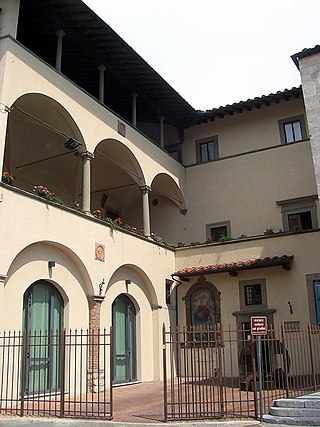
The Cathedral museum of Prato, Italy was founded in 1967 in a few rooms of the Bishop's residence and in 1976 grew to include items from both the Cathedral of Saint Stephen and the diocesan territory.
The Diocesan museum of Genoa is located in Genova in the region of Liguria. It is found inside the old residence of the canons of the Cathedral of San Lorenzo and is accessible through the cloister of San Lorenzo. The cloister, built in the 12th century, is characterized by two levels of arches resting on double Romanesque columns with leaved capitals. In the 17th century two sides of the building were modified, with the double columns substituted with heavy pilasters in order to support the above two floors constructed for additional space. The museum houses objects from the diocese of Genoa and the surrounding area, including sculptures, paintings, frescoes, illuminated manuscripts, and a series of liturgical items, as well as an archeological area.